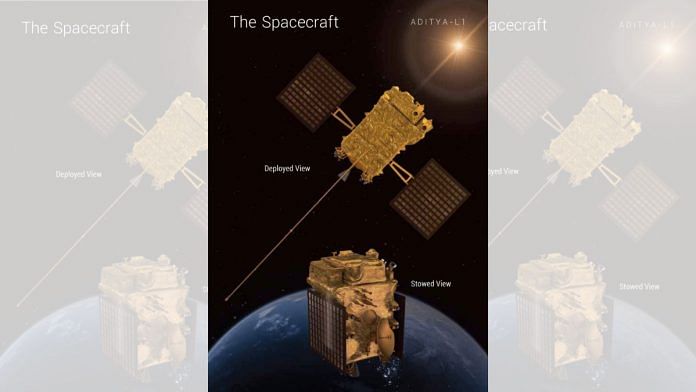New Delhi: Close on the heels of a successful lunar landing last week, the Indian Space Research Organisation (ISRO) announced Monday that its solar mission Aditya-L1 was scheduled for 2 September at 11:50 am.
ISRO invited citizens to witness the launch from the viewing gallery of the spaceport Sriharikota in Andhra Pradesh, by registering on its website.
🚀PSLV-C57/🛰️Aditya-L1 Mission:
The launch of Aditya-L1,
the first space-based Indian observatory to study the Sun ☀️, is scheduled for
🗓️September 2, 2023, at
🕛11:50 Hrs. IST from Sriharikota.
Citizens are invited to witness the launch from the Launch View Gallery at… pic.twitter.com/bjhM5mZNrx
— ISRO (@isro) August 28, 2023
ISRO’s first space-based mission to study the Sun, the Aditya-L1 spacecraft is designed to remotely observe the solar corona and provide in-situ scrutiny of the solar wind at L1 (Sun-Earth Lagrangian point), which is about 1.5 million kilometres from the earth.
The mission, which will study the Sun from an orbit around the L1, will carry seven payloads to observe the photosphere, chromosphere and the outermost layers of the Sun, and the corona in different wavebands.
The spacecraft will be placed in a halo orbit around the L1 of the Sun-Earth system. A satellite placed here has the advantage of continuously viewing the Sun without any eclipses, ISRO has said.
“This will provide a greater advantage of observing the solar activities and its effect on space weather in real time,” the space agency previously said.
The instruments of Aditya-L1 are tuned to observe the solar atmosphere, mainly the chromosphere and corona. In-situ instruments will observe the local environment at L1.
Using the special vantage point, four payloads will directly view the Sun and the remaining three will carry out in-situ studies of particles and fields at the L1, thus providing important scientific studies of the propagatory effect of solar dynamics in the interplanetary medium.
The mission is a fully-indigenous effort with the participation of other national institutions.
The Bengaluru-based Indian Institute of Astrophysics (IIA) is the lead for the development of the “visible emission line coronagraph” payload.
The Inter-University Centre for Astronomy and Astrophysics, Pune, has developed the “solar ultraviolet imager” payload for the mission.
Aditya-L1 can provide observations on the corona, and on the solar chromosphere with the UV payload and on the flares with the X-ray payloads.
The “particle detectors and the magnetometer” payload can provide information on charged particles and the magnetic field reaching the halo orbit around L1.
The stated scientific objectives of Aditya-L1 mission are – the study of solar upper atmospheric (chromosphere and corona) dynamics; the study of chromospheric and coronal heating, physics of the partially ionised plasma, initiation of the coronal mass ejections, and flares; and to observe the in-situ particle and plasma environment providing data for the study of particle dynamics from the Sun.
Also read: Explainer-What is India’s next space mission after moon landing?



